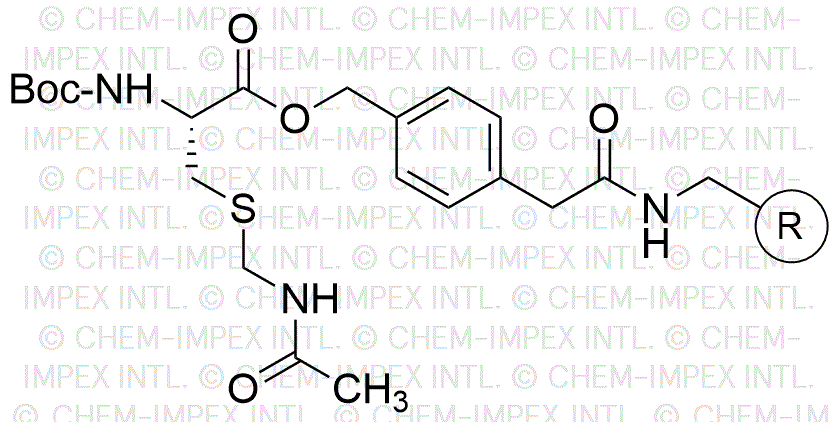Boc-S-acetamidomethyl-L-cysteine 4-oxymethylphenylacetamidomethyl is widely utilized in research focused on:
- Peptide Synthesis: This compound serves as a protecting group in the synthesis of peptides, allowing for selective reactions without interfering with other functional groups.
- Drug Development: It plays a crucial role in the development of pharmaceuticals, particularly in creating compounds that target specific biological pathways.
- Bioconjugation: The compound is used in bioconjugation techniques, facilitating the attachment of biomolecules to surfaces or other molecules for enhanced functionality.
- Research in Cancer Therapeutics: It is applied in studies aimed at developing targeted therapies for cancer, helping to create more effective treatment options.
- Diagnostics: This chemical is involved in the formulation of diagnostic agents, improving the accuracy of disease detection and monitoring.
Informations générales
Propriétés
Sécurité et réglementation
Applications
Boc-S-acetamidomethyl-L-cysteine 4-oxymethylphenylacetamidomethyl is widely utilized in research focused on:
- Peptide Synthesis: This compound serves as a protecting group in the synthesis of peptides, allowing for selective reactions without interfering with other functional groups.
- Drug Development: It plays a crucial role in the development of pharmaceuticals, particularly in creating compounds that target specific biological pathways.
- Bioconjugation: The compound is used in bioconjugation techniques, facilitating the attachment of biomolecules to surfaces or other molecules for enhanced functionality.
- Research in Cancer Therapeutics: It is applied in studies aimed at developing targeted therapies for cancer, helping to create more effective treatment options.
- Diagnostics: This chemical is involved in the formulation of diagnostic agents, improving the accuracy of disease detection and monitoring.
Documents
Fiches de données de sécurité (FDS)
La FDS fournit des informations de sécurité complètes sur la manipulation, le stockage et l’élimination du produit.
Spécifications du produit (PS)
Le PS fournit une description complète des propriétés du produit, notamment sa composition chimique, son état physique, sa pureté et les exigences de stockage. Il détaille également les plages de qualité acceptables et les applications prévues du produit.
Certificats d'analyse (COA)
Recherchez des certificats d'analyse (COA) en saisissant le numéro de lot du produit. Les numéros de lot et de lot se trouvent sur l'étiquette d'un produit, après les mots « Lot » ou « Lot de fabrication ».
Numéro de catalogue
Numéro de lot/série
Certificats d'origine (COO)
Ce certificat d'exploitation confirme le pays dans lequel le produit a été fabriqué, et détaille également les matériaux et composants utilisés et s'il est issu de sources naturelles, synthétiques ou autres sources spécifiques. Ce certificat peut être requis pour les douanes, le commerce et la conformité réglementaire.
Numéro de catalogue
Numéro de lot/série
Fiches de données de sécurité (FDS)
La FDS fournit des informations de sécurité complètes sur la manipulation, le stockage et l’élimination du produit.
DownloadSpécifications du produit (PS)
Le PS fournit une description complète des propriétés du produit, notamment sa composition chimique, son état physique, sa pureté et les exigences de stockage. Il détaille également les plages de qualité acceptables et les applications prévues du produit.
DownloadCertificats d'analyse (COA)
Recherchez des certificats d'analyse (COA) en saisissant le numéro de lot du produit. Les numéros de lot et de lot se trouvent sur l'étiquette d'un produit, après les mots « Lot » ou « Lot de fabrication ».
Numéro de catalogue
Numéro de lot/série
Certificats d'origine (COO)
Ce certificat d'exploitation confirme le pays dans lequel le produit a été fabriqué, et détaille également les matériaux et composants utilisés et s'il est issu de sources naturelles, synthétiques ou autres sources spécifiques. Ce certificat peut être requis pour les douanes, le commerce et la conformité réglementaire.


